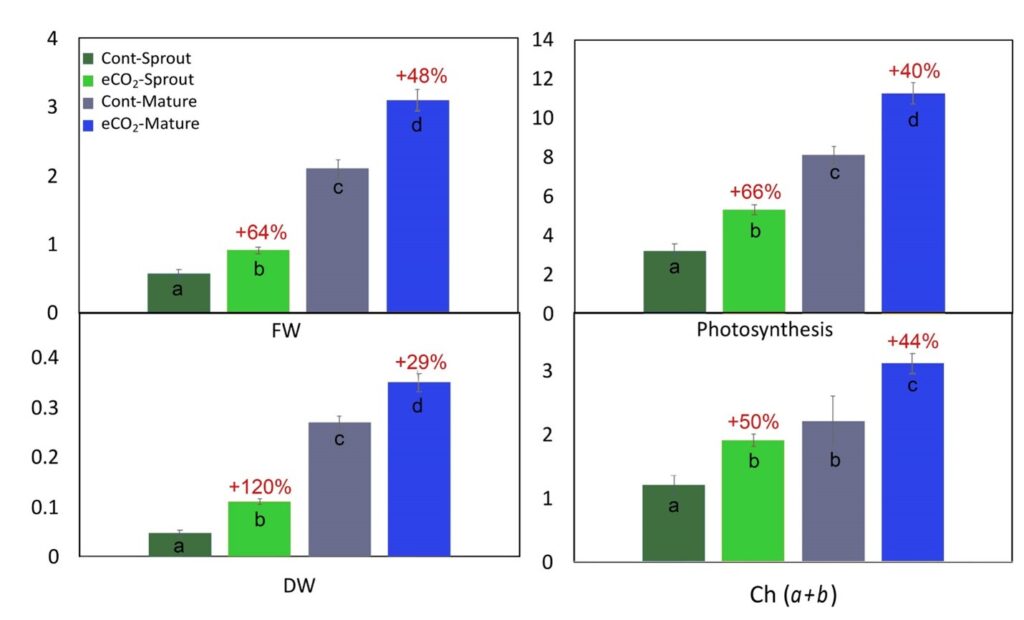Elevated CO2 and the Enhancement of Plant Medicinal Properties
By Craig D. Idso -- June 9, 2022“Over the past quarter-century I have archived a number of such studies on my CO2 Science website under the topic Health Effects (Carbon Dioxide: Health-Promoting Substances, Medicinal Plants. Read for yourself about this incredible benefit that the world is experiencing as the air’s CO2 content continues its upward rise. It will give you a whole new perspective on the many benefits of atmospheric CO2 enrichment.”
Over the past few decades an increasing number of studies have investigated whether or not rising atmospheric CO2 will alter the amounts and concentrations of various health-promoting substances found in medicinal or “health food” plants.
For example, the research team of AbdElgawad et al. (2021) recently examined “the nutritive values, phytochemicals (i.e., pigments, phenolics, flavonoids, vitamins, mineral profiles and essential oil yields) and antioxidant activities of both caraway sprouts and mature plants.”
Caraway (Carum carvi) is an important medicinal plant. They are cultivated across the globe and used in treating a number of ailments, including diarrhea, asthma, cholera and hypertension. What is more, AbdElgawad et al. note that caraway fruits “have been prescribed in herbal mixtures as a drug for digestive, carminative and lactogenic disorders,” and they are also utilized as “antiallergic, antibacterial, anthelmintic, antifungal, bronchodilator and cholinergic agents.”
In light of these many traditional uses of caraway plants, it should come as no surprise that multiple strategies have been employed to improve its growth and medicinal properties, including CO2 enrichment. Because rising levels of atmospheric CO2 typically promote plant photosynthesis and the production of secondary compounds, the twelve-member research team anticipated that elevated CO2 would also enhance the medicinal properties of caraway.
To explore their hypothesis, AbdElgawad et al. grew caraway in controlled-environment chambers under ambient (400 ppm) or elevated (620 ppm) CO2 conditions, harvesting the plants after 9 or 45 days (as sprouts or mature plants, respectively). Thereafter, they performed a series of analyses designed to quantify the CO2-induced differences in plant medicinal properties.
And what did those analyses reveal?
First, as shown in Figure 1, the 220 ppm increase in atmospheric CO2 enhanced the photosynthesis, chlorophyll content, fresh weight and dry weight of the sprouts by 66%, 50%, 64% and 120%, respectively. Similarly, significant CO2-induced enhancements in these four parameters were also observed in the mature plants (40%, 44%, 48% and 29% for photosynthesis, chlorophyll content, fresh weight and dry weight, again respectively).
AbdElgawad et al., further report that elevated CO2 significantly increased the production of carbohydrates, proteins, fats and crude fibers in caraway, as well as organic and amino acids, regardless of growth stage (sprout or mature plants). Higher CO2 also enhanced plant mineral content, vitamins and phenolics, as well as antioxidant and antibacterial activities.
Commenting on these several findings, the authors state the obvious: “overall, elevated CO2 provoked changes in the phytochemical contents of caraway plants, particularly at the sprouting stage and, hence, improved their nutritive and health-promoting properties.” And they are not alone in this overall assessment. Many other studies conducted on a host of other plants have reported CO2-induced enhancements of substances known to be effective at fighting cancers, diseases and numerous other medical maladies.
Over the past quarter-century I have archived a number of such studies on my CO2 Science website under the topic Health Effects (Carbon Dioxide: Health-Promoting Substances, Medicinal Plants). Click the link and read for yourself about this incredible benefit that the world is experiencing as the air’s CO2 content continues its upward rise. It will give you a whole new perspective on the many benefits of atmospheric CO2 enrichment.

Figure 1. Fresh weight (FW) (mg/g FW), dry weight (DW) (mg/g DW), photosynthesis (µmol CO2 m-m s-s), and pigments content (chlorophyll a + b) (mg/g FW) of caraway sprouts and mature plants grown under control (Cont., 400 ppm) and elevated (eCO2, 620 ppm) concentrations of atmospheric CO2. Data represent means of at least 3 replicates ± standard deviations. Different small letter superscripts (a, b, c and d) within a row indicate significant differences between control and eCO2-samples. One-way analysis of variance (ANOVA) was performed. Tukey’s test was used as the post-hoc test for the separation of means (p < 0.05). The percentages in red text indicate the percent change due to CO2 for a given parameter at either the sprout or mature stage. Source: AbdElgawad et al. (2021).
Reference
AbdElgawad, H., Okla, M.K., Al-amri, S.S., AL-Hashimi, A., Al-Qahtani, W.H., Al-Qahtani, S.M., Abbas, Z.K., Al-Harbi, N.A., Algafar, A.A., Almuhayawi, M.S., Selim, S. and Abdel-Mawgoud, M. Effect of elevated CO2 on biomolecules’ accumulation in caraway (Carum carvi L.) plants at different developmental stages. Plants 2021, 10, 2434.